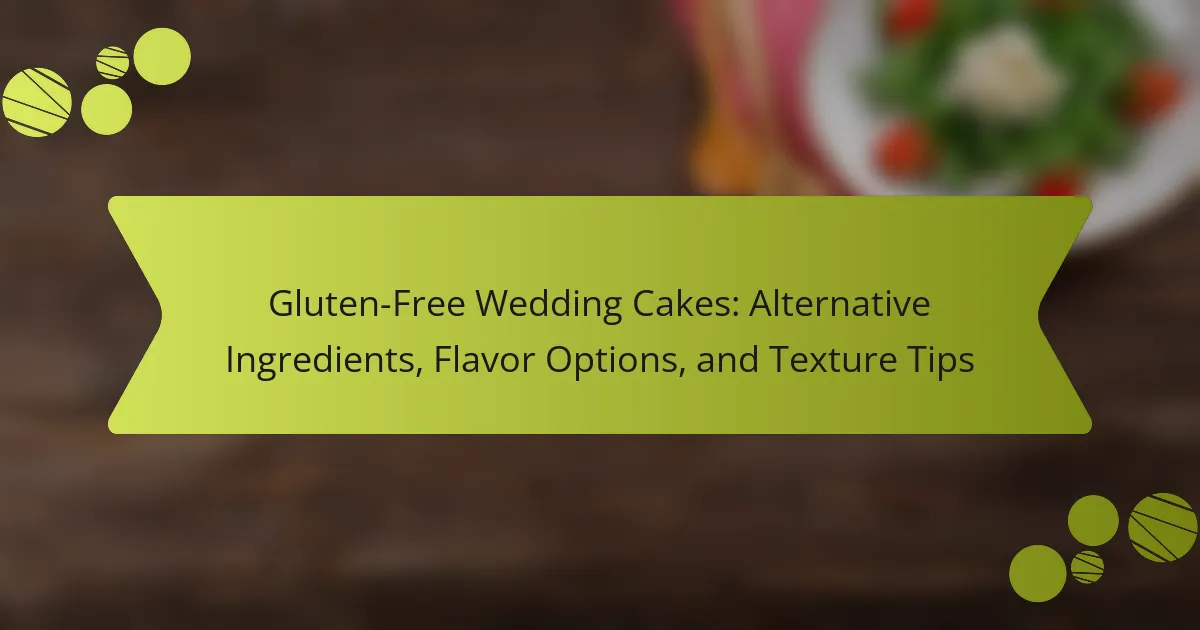Gluten-free wedding cakes are specifically designed for individuals with gluten intolerance or celiac disease, utilizing alternative flours such as almond, coconut, and rice flour. These cakes can be as delicious and visually appealing as traditional options, with a variety of flavors including vanilla, chocolate, lemon, and unique choices like matcha and lavender. To achieve optimal texture, bakers often combine different gluten-free flours and incorporate binding agents such as xanthan gum. Techniques like adjusting baking temperatures and using ingredients like eggs and buttermilk further enhance the cake’s moisture and structure. This article explores the innovative approaches to gluten-free wedding cakes, including ingredient selection and flavor options, catering to the growing demand for gluten-free desserts.

What are Gluten-Free Wedding Cakes?
Gluten-free wedding cakes are cakes made without gluten-containing ingredients. These cakes cater to individuals with gluten intolerance or celiac disease. Common gluten-free flours include almond, coconut, and rice flour. These alternative flours provide different textures and flavors compared to traditional wheat flour. Gluten-free wedding cakes can be just as delicious and visually appealing as standard cakes. Many bakers specialize in creating gluten-free options to meet dietary needs. The demand for gluten-free products has increased significantly, with 1 in 100 people affected by celiac disease globally. This rise in awareness drives innovation in gluten-free baking techniques and recipes.
Why choose a gluten-free wedding cake?
Choosing a gluten-free wedding cake accommodates guests with gluten sensitivities or celiac disease. This ensures all attendees can enjoy the dessert without health concerns. Gluten-free cakes often use alternative flours like almond, coconut, or rice flour. These ingredients can create unique flavors and textures. Many gluten-free cakes are moist and flavorful, appealing to a wide range of palates. Additionally, gluten-free options have gained popularity, making them more readily available. Choosing gluten-free demonstrates consideration for guest dietary needs. This choice can enhance the overall wedding experience for everyone.
What dietary needs do gluten-free cakes address?
Gluten-free cakes address the dietary needs of individuals with celiac disease and gluten sensitivity. Celiac disease affects approximately 1 in 100 people worldwide, causing adverse reactions to gluten. Gluten sensitivity can cause discomfort in those who do not have celiac disease but still react to gluten. By using alternative flours like almond, coconut, or rice flour, gluten-free cakes provide safe dessert options. These cakes also cater to those following a gluten-free diet for health reasons or personal choice. Overall, gluten-free cakes ensure inclusivity for various dietary restrictions.
How do gluten-free cakes differ from traditional cakes?
Gluten-free cakes differ from traditional cakes primarily in their use of gluten-free flours. Traditional cakes typically use wheat flour, which contains gluten, a protein that provides structure and elasticity. Gluten-free cakes substitute wheat flour with alternatives like almond flour, coconut flour, or rice flour. These alternatives often result in a different texture and density.
Gluten-free cakes may require additional binding agents, such as xanthan gum or eggs, to mimic the properties of gluten. The absence of gluten can lead to a crumbly texture if not balanced with proper ingredients. Additionally, gluten-free cakes may have a shorter shelf life due to the lack of preservatives found in some traditional cakes.
Taste can also vary; gluten-free flours can impart unique flavors that differ from the neutral taste of wheat flour. Therefore, gluten-free cakes often need careful recipe adjustments to achieve a desirable flavor and texture.
What are the key ingredients in gluten-free wedding cakes?
The key ingredients in gluten-free wedding cakes include gluten-free flour blends, eggs, sugar, and dairy or dairy alternatives. Gluten-free flour blends often consist of rice flour, almond flour, or tapioca starch. These flours provide structure and texture without gluten. Eggs act as a binding agent, helping to hold the cake together. Sugar adds sweetness and contributes to the cake’s moisture. Dairy options like milk or yogurt enhance flavor and texture, while dairy alternatives like almond milk can be used for a vegan option. These ingredients collectively ensure a delicious and celebratory cake suitable for gluten-sensitive guests.
What alternative flours can be used in gluten-free cakes?
Alternative flours for gluten-free cakes include almond flour, coconut flour, and rice flour. Almond flour adds moisture and a slightly nutty flavor. Coconut flour is highly absorbent and requires more liquid in recipes. Rice flour provides a neutral flavor and good texture. Other options are oat flour, which adds a mild sweetness, and tapioca flour, which enhances chewiness. Each flour has unique properties that affect the cake’s taste and texture.
How do sweeteners and binders contribute to gluten-free cakes?
Sweeteners and binders play crucial roles in gluten-free cakes. Sweeteners provide flavor and moisture, enhancing the overall taste. Common sweeteners include sugar, honey, and agave syrup. They help balance the flavors of gluten-free flours, which can be more neutral or less sweet.
Binders are essential for structure and texture in gluten-free baking. They mimic the role of gluten by helping ingredients stick together. Common binders include eggs, flaxseed meal, and xanthan gum. These ingredients contribute to the cake’s stability and prevent crumbling.
Research shows that using the right combination of sweeteners and binders can significantly improve the texture and flavor profile of gluten-free cakes. A study from the Journal of Food Science highlights that proper binder usage enhances moisture retention and overall cake quality.

What flavor options are available for gluten-free wedding cakes?
Common flavor options for gluten-free wedding cakes include vanilla, chocolate, lemon, and almond. These flavors can be achieved using gluten-free flour blends. Other popular options are red velvet, carrot, and coconut. Fruit flavors like strawberry and raspberry are also frequently chosen. Many bakers incorporate spices such as cinnamon or nutmeg for added depth. Unique flavors like matcha or lavender are gaining popularity. Each flavor can be paired with gluten-free frostings for a complete dessert. This variety ensures that gluten-free wedding cakes can satisfy diverse tastes.
How can you incorporate unique flavors into gluten-free cakes?
Incorporating unique flavors into gluten-free cakes can be achieved through various methods. Use natural extracts like vanilla, almond, or citrus to enhance flavor profiles. Incorporate spices such as cinnamon, nutmeg, or cardamom for warmth and depth. Experiment with fruit purees, like mango or raspberry, to add moisture and distinct taste. Utilize alternative flours, such as almond or coconut flour, which impart unique flavors. Add zests from citrus fruits to brighten the cake’s overall flavor. Consider infusing the batter with herbs like rosemary or basil for a savory twist. Each method can transform the cake while maintaining its gluten-free integrity.
What are popular flavor combinations for gluten-free wedding cakes?
Popular flavor combinations for gluten-free wedding cakes include chocolate and raspberry, lemon and almond, and vanilla and strawberry. Chocolate and raspberry provide a rich and fruity contrast. Lemon and almond offer a refreshing and nutty profile. Vanilla and strawberry create a classic and sweet pairing. These combinations are favored for their balance and appeal. Many couples choose these flavors for their unique tastes and visual presentation.
How do flavorings and extracts enhance gluten-free cakes?
Flavorings and extracts significantly enhance gluten-free cakes by adding depth and complexity to their taste. Gluten-free flours often lack the rich flavors found in traditional wheat-based cakes. Flavorings like vanilla, almond, or citrus extracts can infuse the cake with appealing aromas and tastes. These enhancements help mask any potential off-flavors from gluten-free ingredients. Additionally, flavorings can improve the overall sensory experience, making the cake more enjoyable. Studies show that the right flavor combinations can elevate the perception of sweetness and richness in gluten-free baked goods. Therefore, incorporating various flavorings and extracts is essential for creating delicious gluten-free cakes.
What role do fillings and frostings play in flavor?
Fillings and frostings significantly enhance the flavor of gluten-free wedding cakes. They provide moisture, sweetness, and richness, which complement the cake’s base. Fillings can introduce contrasting flavors, such as fruit, chocolate, or cream, creating a layered taste experience. Frostings, on the other hand, can add texture and visual appeal along with flavor. Common frostings like buttercream or cream cheese can balance sweetness and provide a creamy mouthfeel. The combination of fillings and frostings allows for greater flavor complexity and customization in gluten-free cakes. This versatility is crucial for meeting diverse taste preferences during weddings.
Which gluten-free fillings complement cake flavors?
Gluten-free fillings that complement cake flavors include fruit purees, cream cheese, and ganache. Fruit purees, like raspberry or lemon, add a fresh and tangy contrast to sweet cakes. Cream cheese provides a rich and creamy texture that pairs well with spiced cakes. Ganache offers a decadent chocolate option that enhances chocolate or vanilla cakes. Additionally, custards and mousse fillings can introduce a light and airy element to cakes. These fillings not only enhance flavor but also maintain the desired texture in gluten-free cakes.
How can frostings be made gluten-free without sacrificing taste?
Frostings can be made gluten-free without sacrificing taste by using gluten-free powdered sugar and alternative thickening agents. Gluten-free powdered sugar is widely available and provides the same sweetness as regular powdered sugar. Alternative thickening agents like cornstarch or arrowroot can be used to achieve the desired texture.
Incorporating natural flavorings such as vanilla extract, cocoa powder, or fruit purees can enhance the taste. These ingredients are naturally gluten-free and add depth to the frosting. Additionally, using high-quality butter or dairy-free alternatives can improve the mouthfeel and richness of the frosting.
Many gluten-free frostings maintain a creamy consistency and rich flavor, making them suitable for various desserts. This approach ensures that the frosting remains delicious while adhering to gluten-free standards.

How can the texture of gluten-free wedding cakes be improved?
To improve the texture of gluten-free wedding cakes, incorporating a blend of gluten-free flours is essential. Using a combination of almond flour, coconut flour, and tapioca flour can enhance moisture and structure. Adding xanthan gum or guar gum helps mimic gluten’s elasticity and improves the cake’s overall texture.
Including eggs in the recipe provides additional binding and moisture, resulting in a fluffier cake. Utilizing buttermilk or yogurt can also add richness and tenderness to the crumb.
Baking at a lower temperature for a longer duration allows for even cooking, preventing dryness. Lastly, allowing the cake to cool completely before frosting can help maintain its texture. These methods are supported by baking experts who emphasize the importance of ingredient selection and technique in gluten-free baking.
What techniques can enhance the texture of gluten-free cakes?
To enhance the texture of gluten-free cakes, use techniques like incorporating moisture-rich ingredients. Ingredients such as applesauce or yogurt can add moisture and improve softness. Another technique is to blend different gluten-free flours. Combining almond flour with coconut flour can create a better crumb structure.
Utilizing eggs effectively can also enhance texture. Eggs provide structure and stability in gluten-free baking. Additionally, adding a starch like cornstarch or tapioca flour can improve the cake’s lightness.
Incorporating baking soda or baking powder can help with rise and fluffiness. Finally, allowing the batter to rest before baking can improve the texture by hydrating the flours. These techniques collectively contribute to a more desirable texture in gluten-free cakes.
How does the mixing process affect cake texture?
The mixing process significantly influences cake texture. Proper mixing incorporates air into the batter, leading to a lighter cake. Over-mixing can develop gluten in wheat-based cakes, resulting in a dense texture. For gluten-free cakes, mixing must be carefully controlled to avoid a gummy consistency. The type of mixing method also matters; creaming butter and sugar creates a tender crumb. Additionally, the duration of mixing affects moisture retention. Shorter mixing times can yield a more delicate texture. Research shows that mixing techniques directly correlate with the final product’s structure and mouthfeel.
What baking methods yield the best results for gluten-free cakes?
The best baking methods for gluten-free cakes include using a combination of baking techniques and ingredients. Techniques like the reverse creaming method help achieve a lighter texture. This method involves mixing dry ingredients with fat before adding wet ingredients. Additionally, using a steam-injected oven can create moisture, preventing dryness in gluten-free cakes.
Incorporating ingredients like almond flour or coconut flour can also enhance texture. These flours provide a different structure compared to traditional wheat flour. Using xanthan gum or guar gum can improve elasticity and binding in gluten-free batters.
Research indicates that these methods and ingredients lead to better rise and crumb structure. A study by the Journal of Food Science highlights that proper ingredient combinations significantly affect gluten-free cake quality.
What common challenges do bakers face with gluten-free cakes?
Bakers face several common challenges when making gluten-free cakes. One major challenge is achieving the right texture. Gluten provides structure, and without it, cakes can become dense or crumbly. Another challenge is moisture retention. Gluten-free flours often absorb more liquid, leading to dry cakes if not properly balanced. Flavor can also be an issue, as some gluten-free flours have distinct tastes that may not appeal to all. Additionally, bakers may struggle with rising, as gluten-free cakes often do not rise as well as traditional cakes. Lastly, ingredient substitutions can complicate recipes, requiring experimentation to find the right combinations. These challenges highlight the complexities of gluten-free baking.
How can you troubleshoot dry or crumbly gluten-free cakes?
To troubleshoot dry or crumbly gluten-free cakes, first ensure you are using enough moisture in your recipe. Gluten-free flours often absorb more liquid than wheat flour. Consider adding ingredients like applesauce, yogurt, or additional eggs to increase moisture content.
Next, check the baking time and temperature. Overbaking can lead to dryness. Use an oven thermometer to ensure accurate baking temperatures.
Additionally, consider the type of gluten-free flour used. Blends with xanthan gum or guar gum can improve texture and moisture retention.
Finally, allow the cake to cool in the pan for a short time before transferring it to a wire rack. This can help retain moisture.
What tips can help achieve a moist gluten-free cake?
To achieve a moist gluten-free cake, incorporate ingredients that retain moisture. Use almond flour or coconut flour, as they absorb moisture better than regular flour. Adding applesauce or yogurt can enhance moisture content. Ensure to include eggs, which provide structure and moisture. Baking at a lower temperature prevents over-drying. Do not overmix the batter; this can lead to a denser texture. Use a simple syrup to brush on the cake layers before frosting. These methods are effective in creating a moist gluten-free cake.
What are the best practices for serving gluten-free wedding cakes?
The best practices for serving gluten-free wedding cakes include ensuring proper storage, avoiding cross-contamination, and providing clear labeling. Store gluten-free cakes in airtight containers to maintain freshness. Use separate utensils and serving dishes to prevent gluten exposure. Clearly label the cake to inform guests about its gluten-free status. These practices ensure safety for guests with gluten sensitivities. According to the Celiac Disease Foundation, cross-contamination can occur easily in shared environments, making these precautions essential.
Gluten-free wedding cakes are specially crafted desserts that omit gluten-containing ingredients, catering to individuals with gluten intolerance or celiac disease. This article covers the essential aspects of gluten-free wedding cakes, including alternative ingredients like almond, coconut, and rice flour, as well as various flavor options and techniques to enhance texture. It addresses dietary needs, compares gluten-free cakes to traditional ones, and provides tips for achieving moist and flavorful results. Additionally, the article discusses common challenges bakers face and best practices for serving gluten-free cakes safely to guests.
